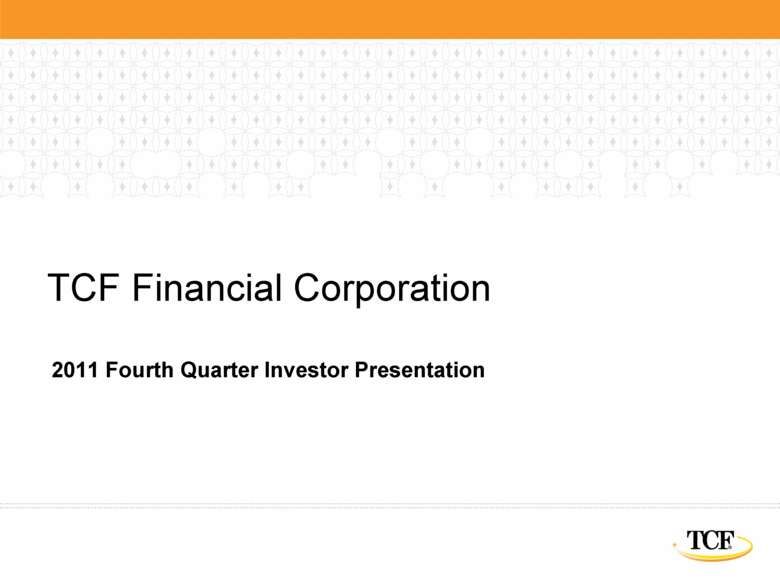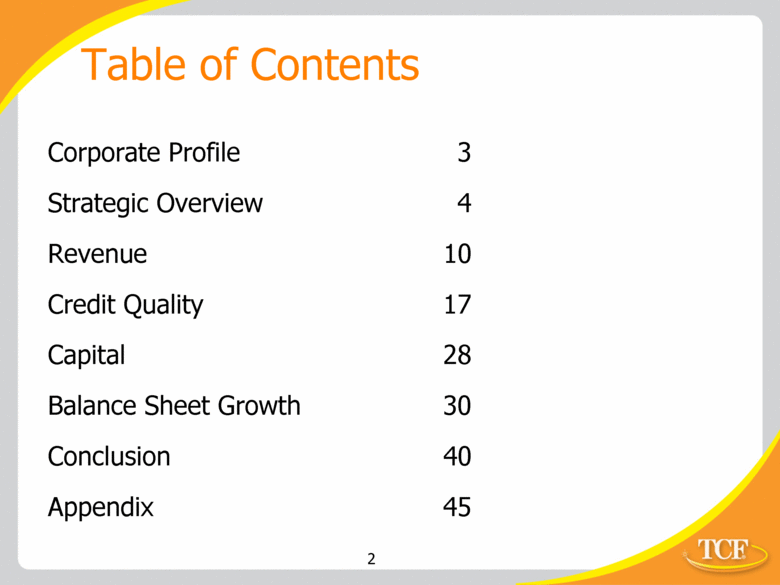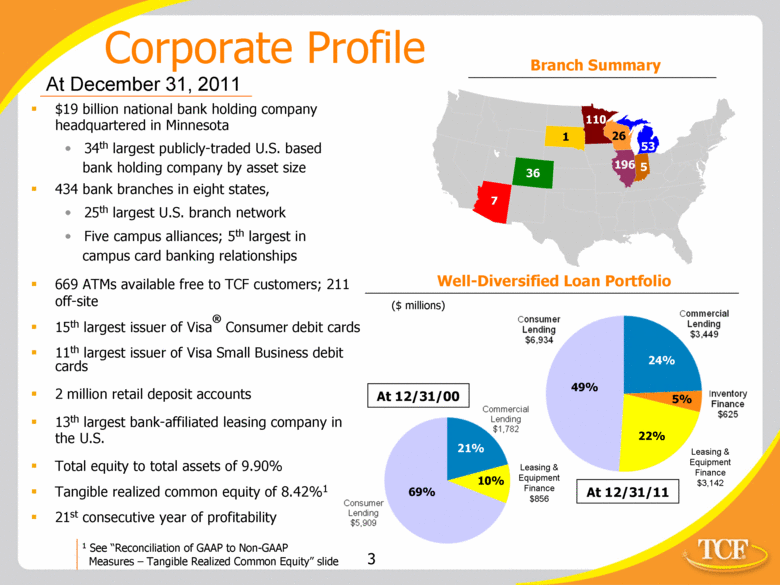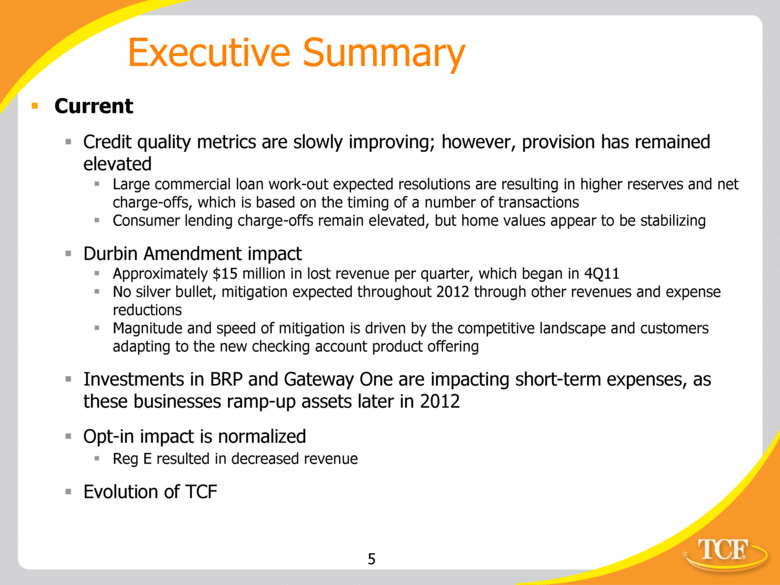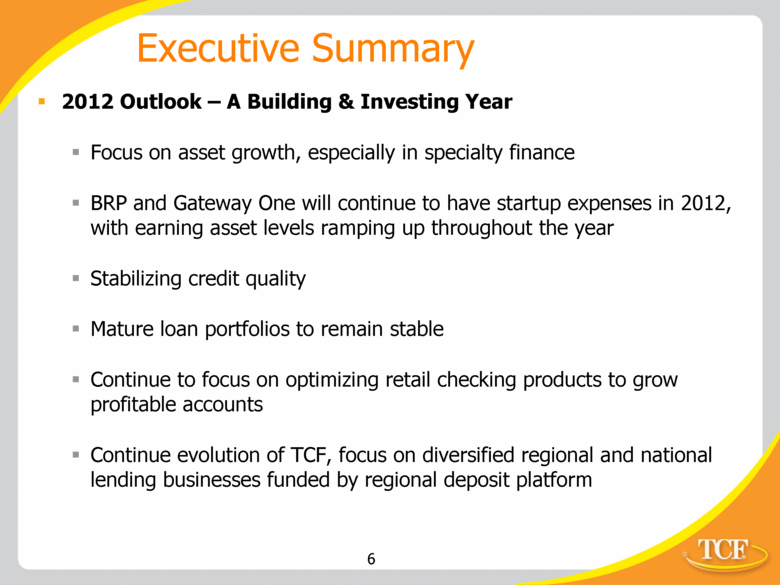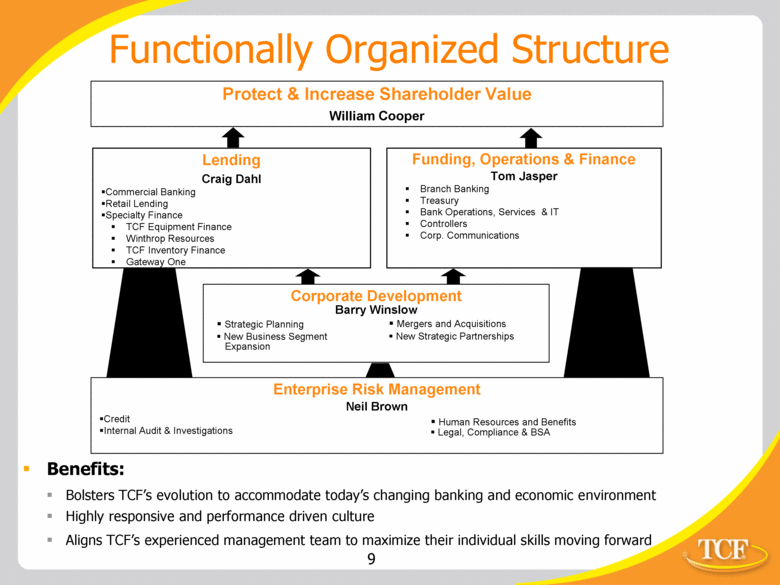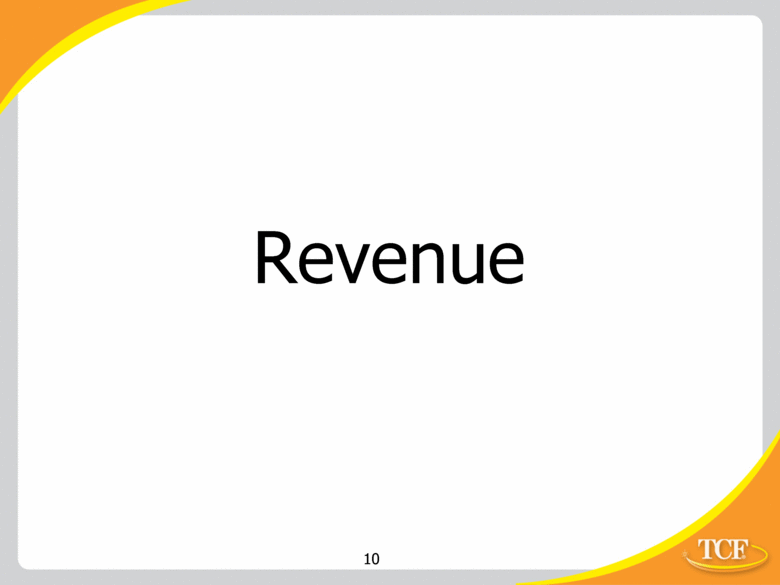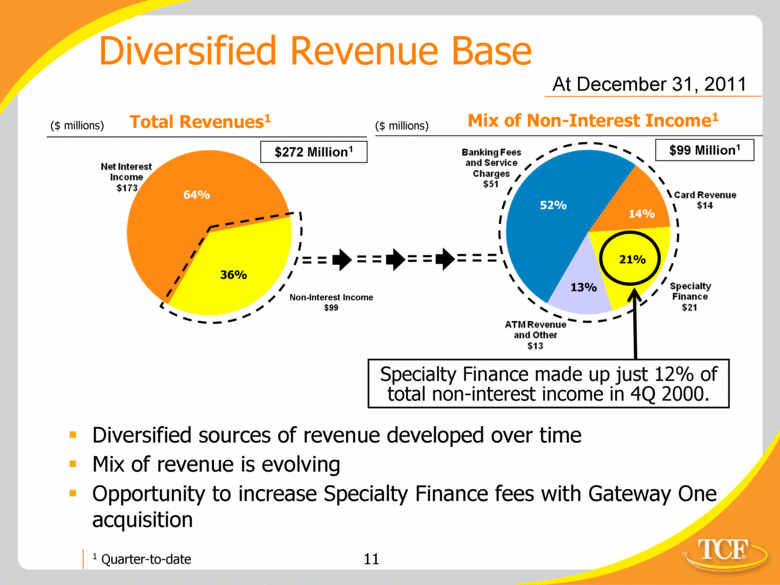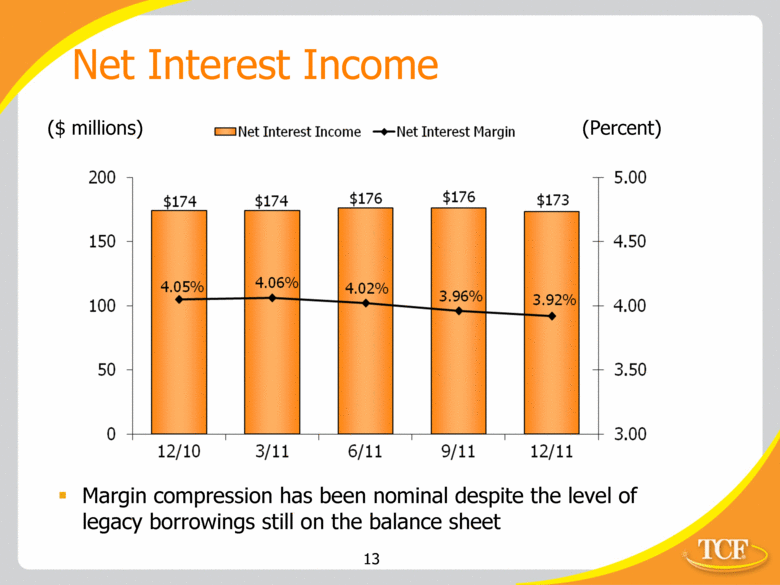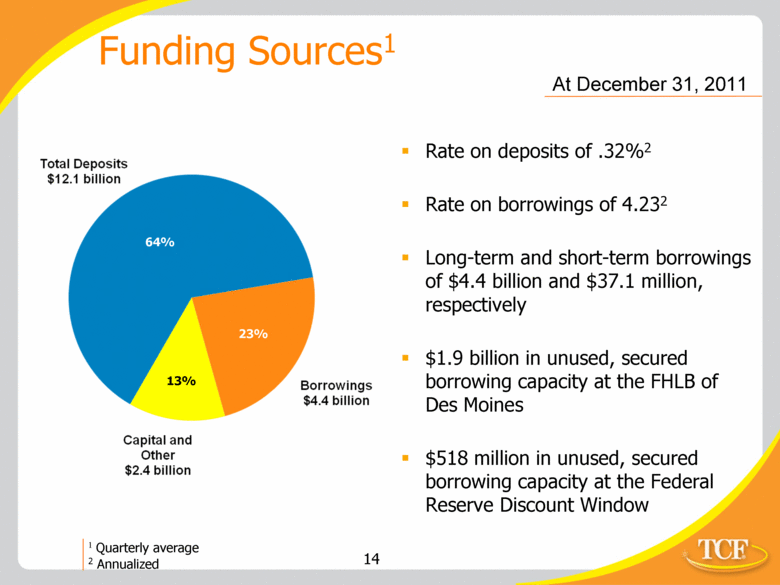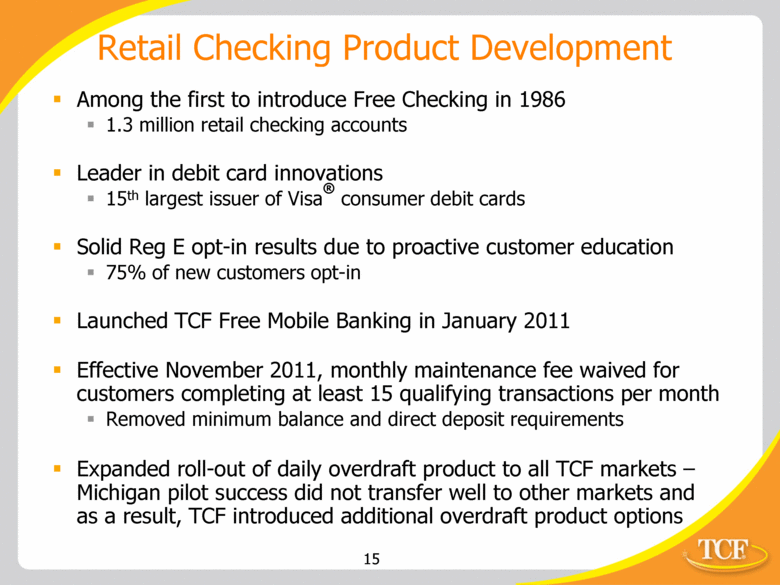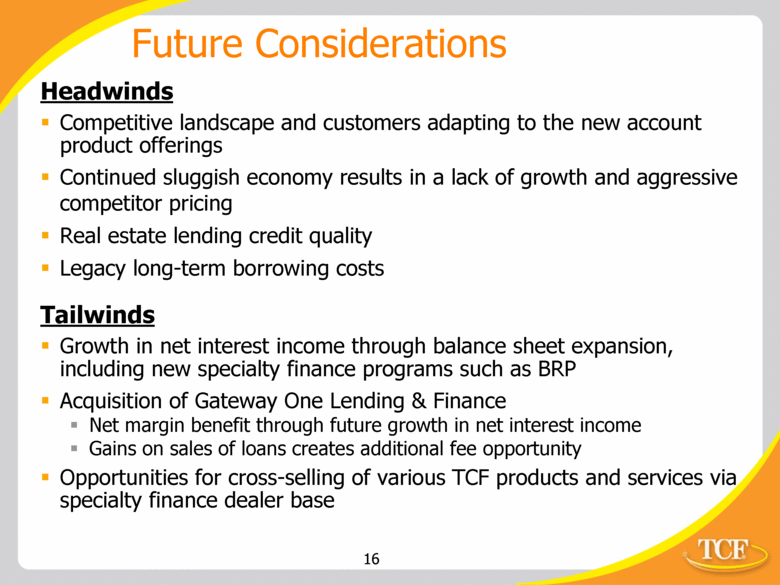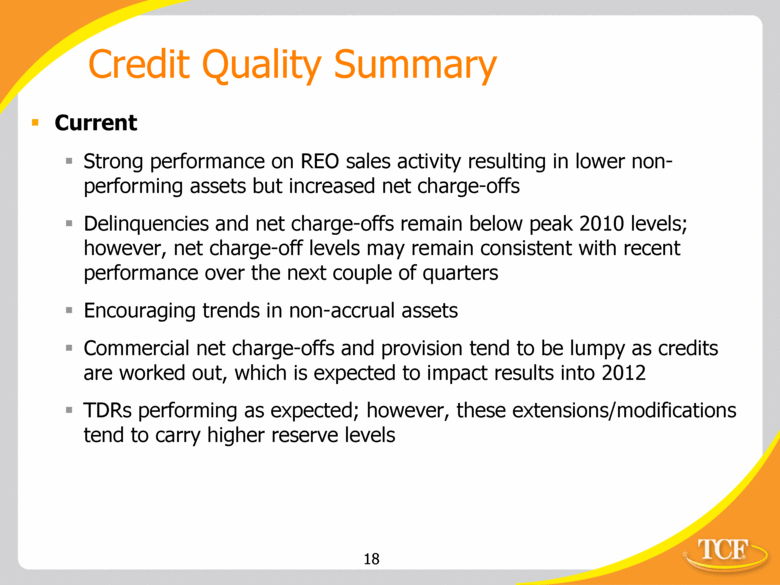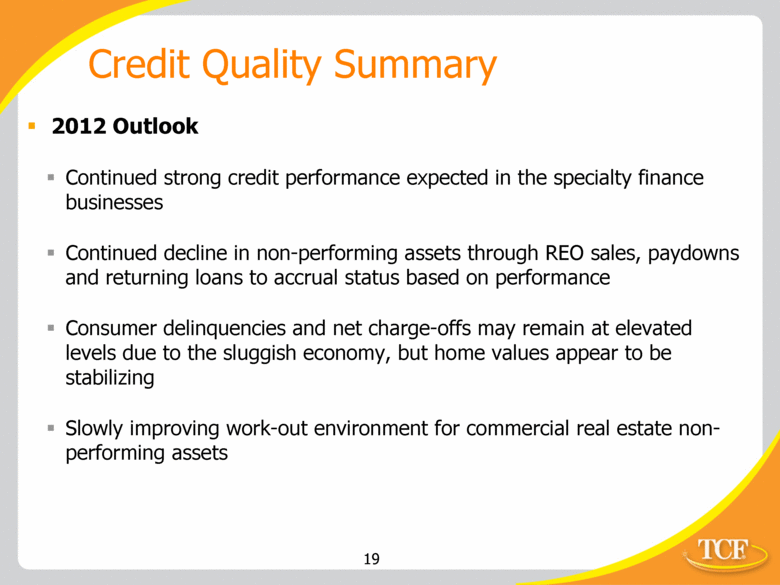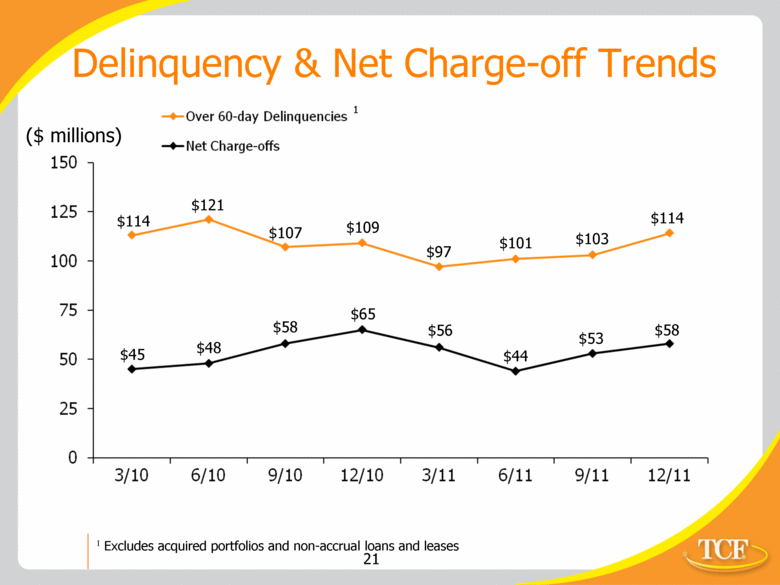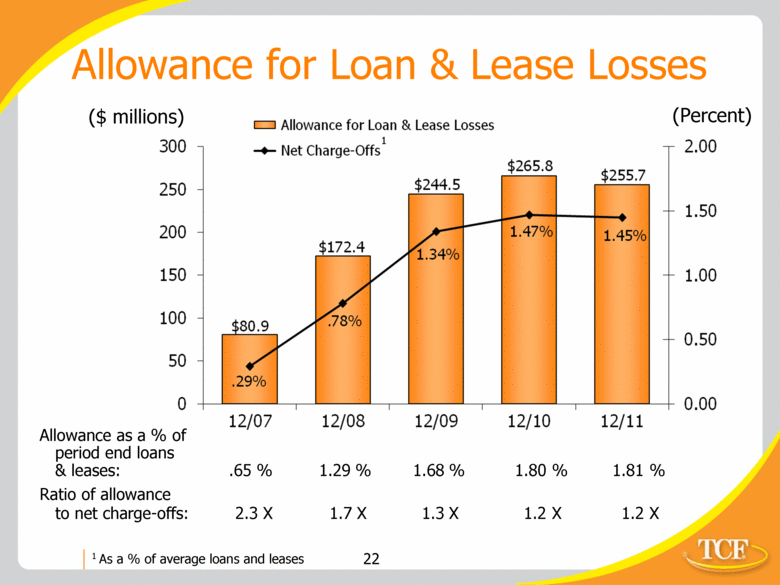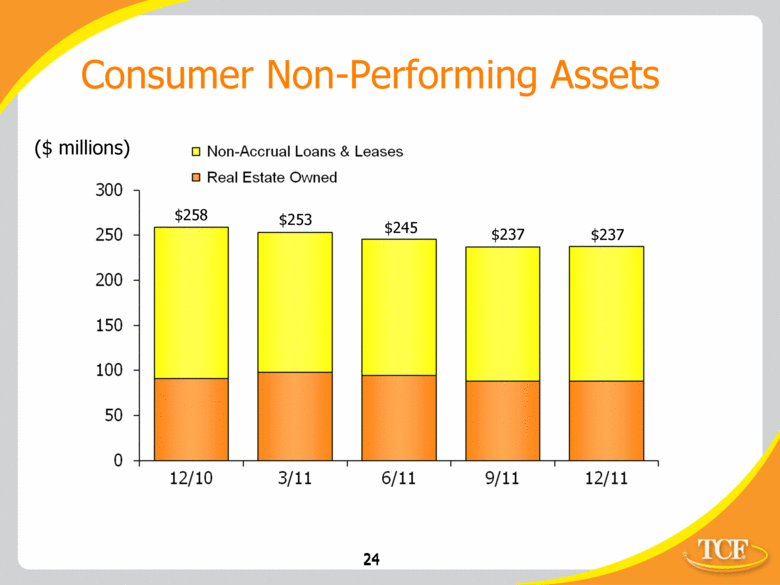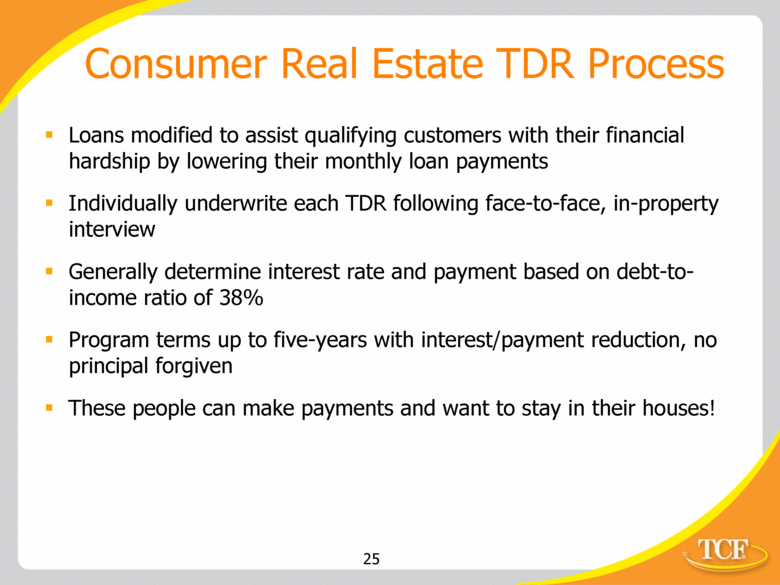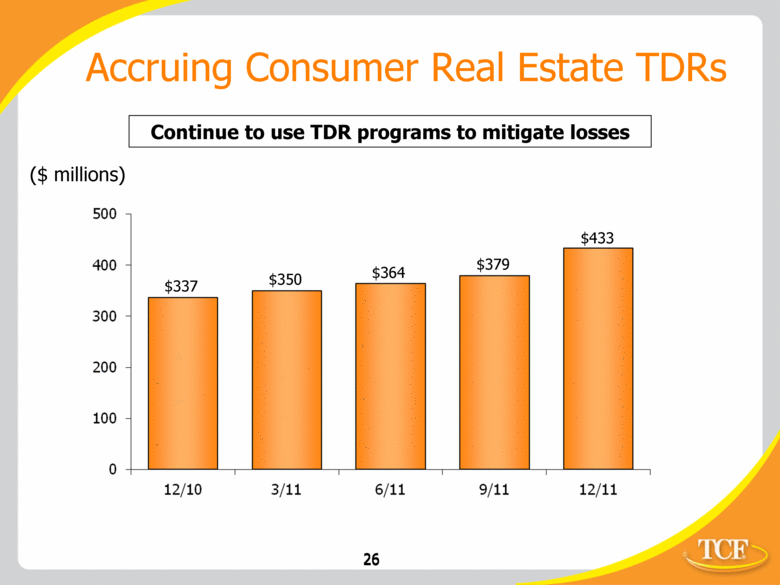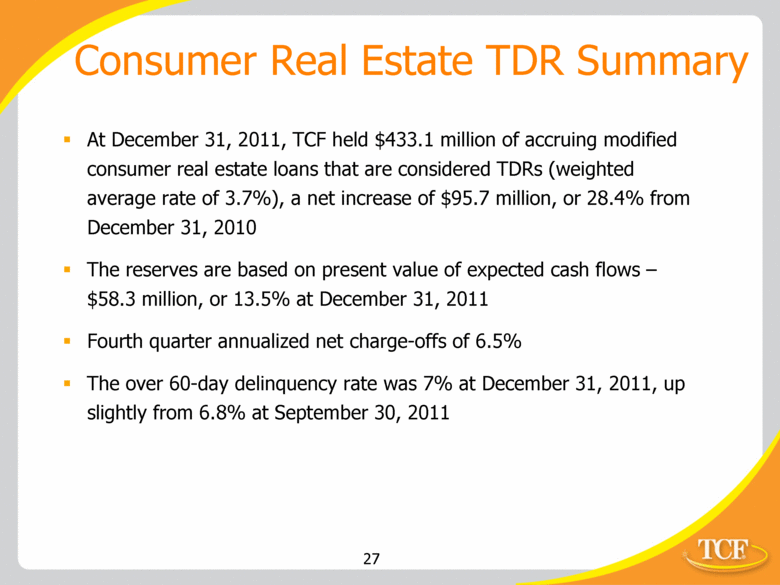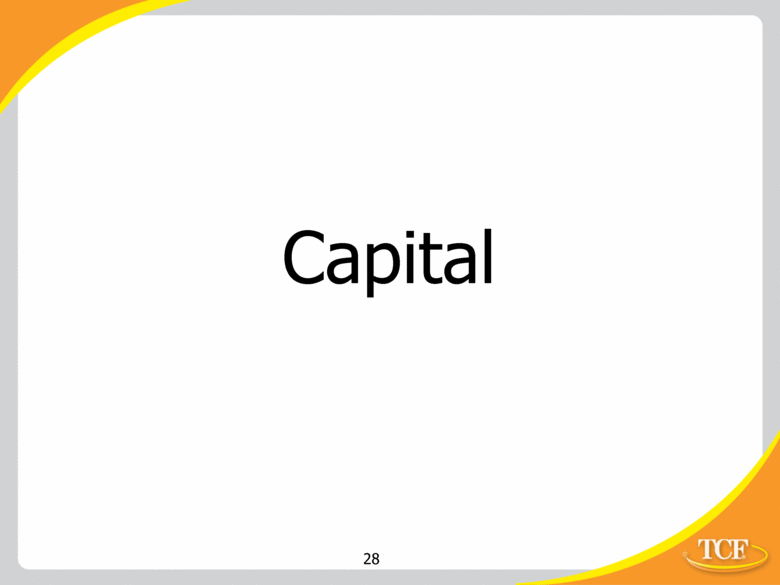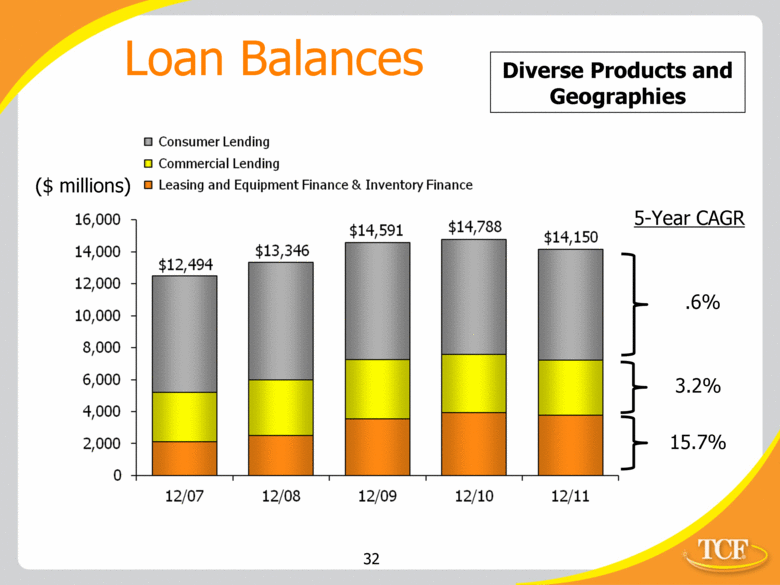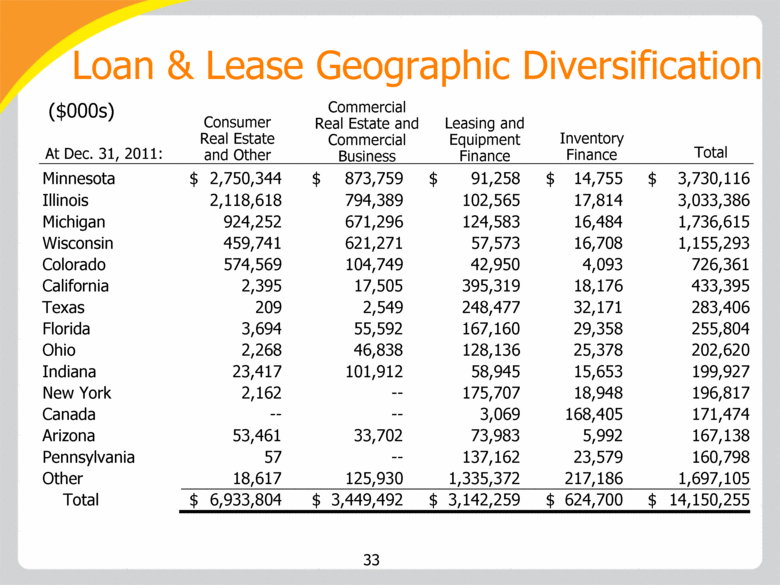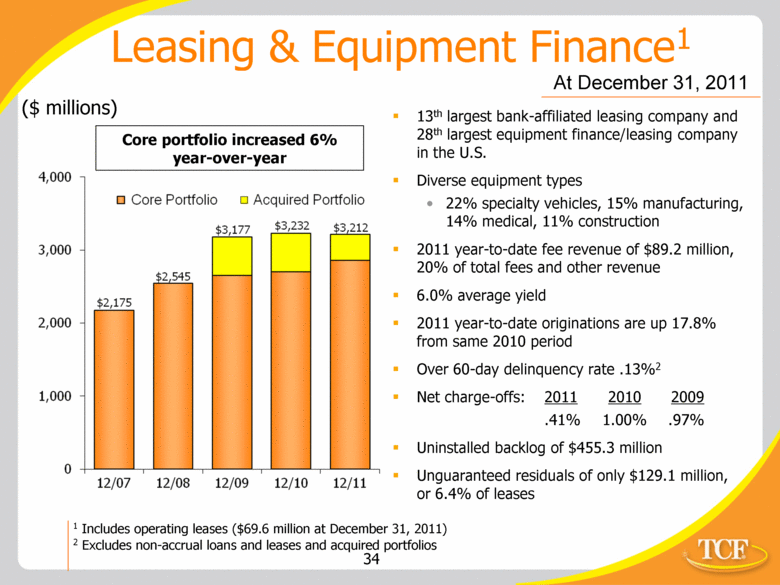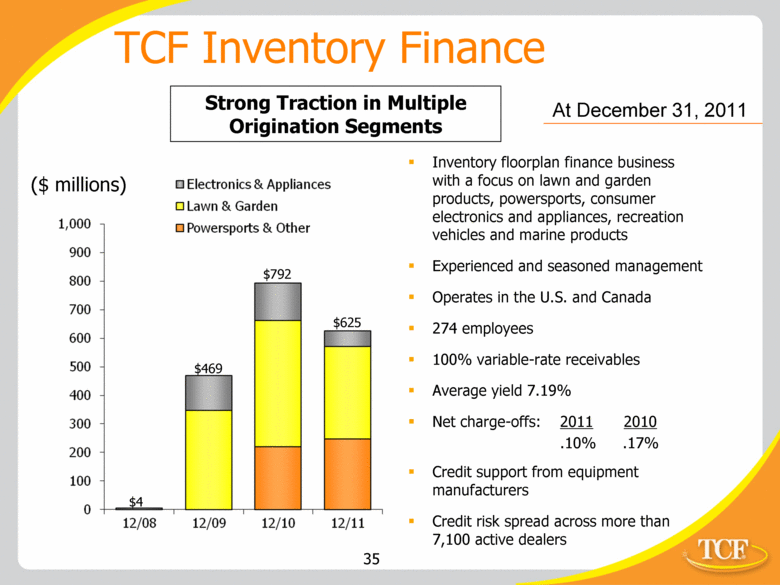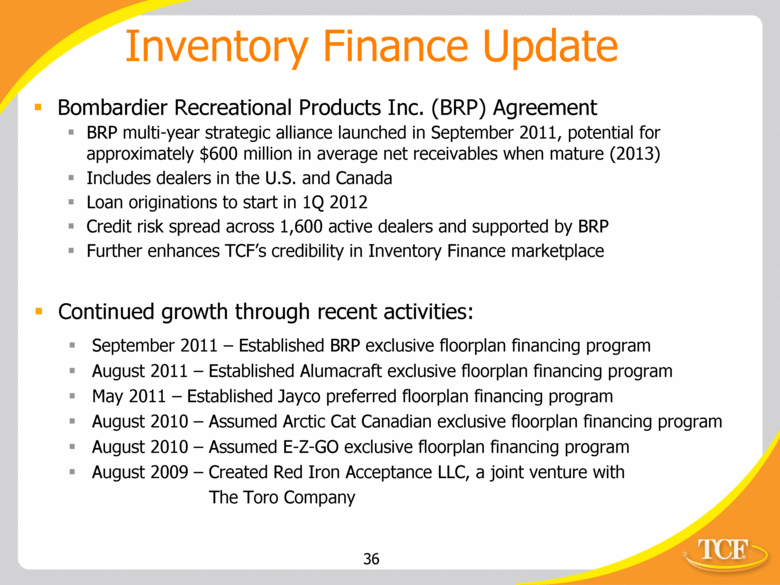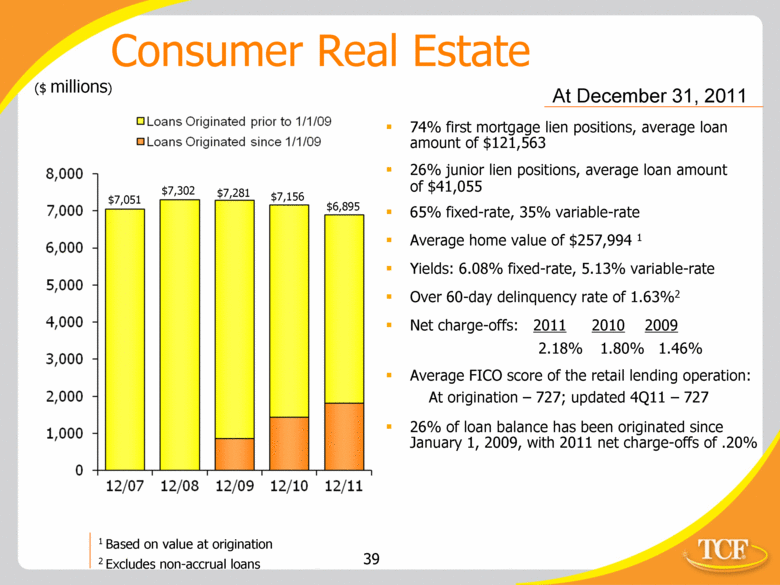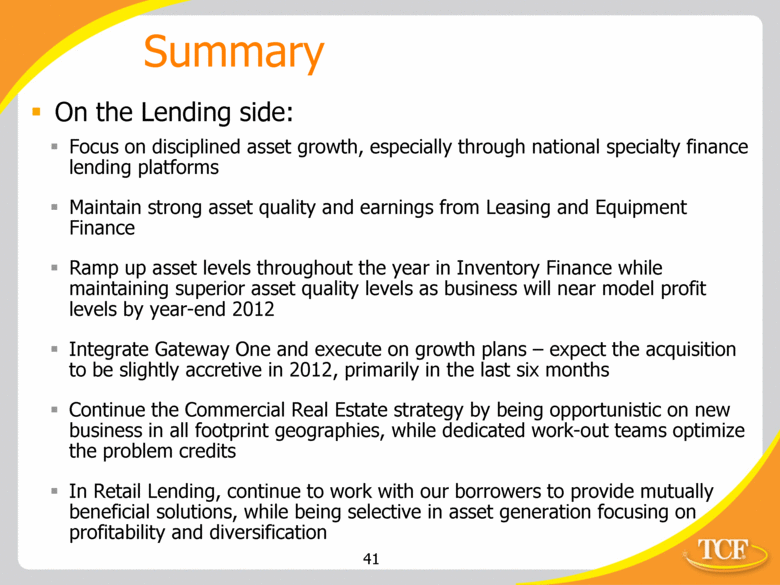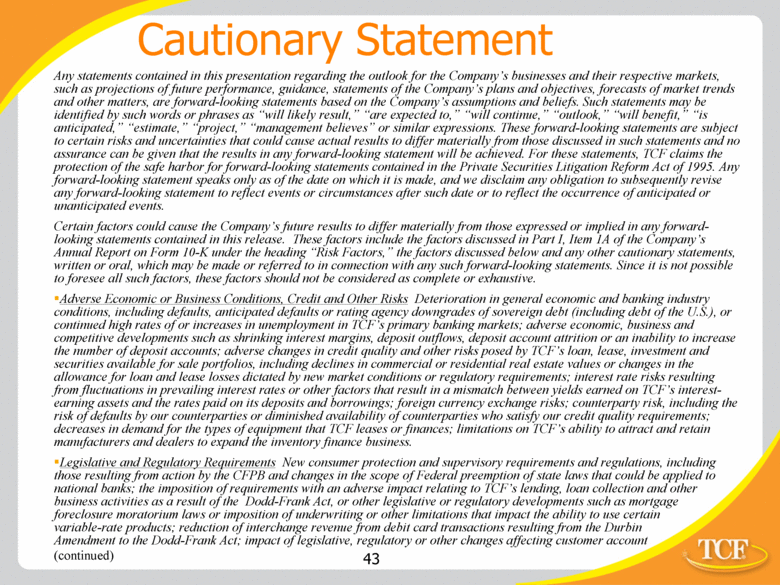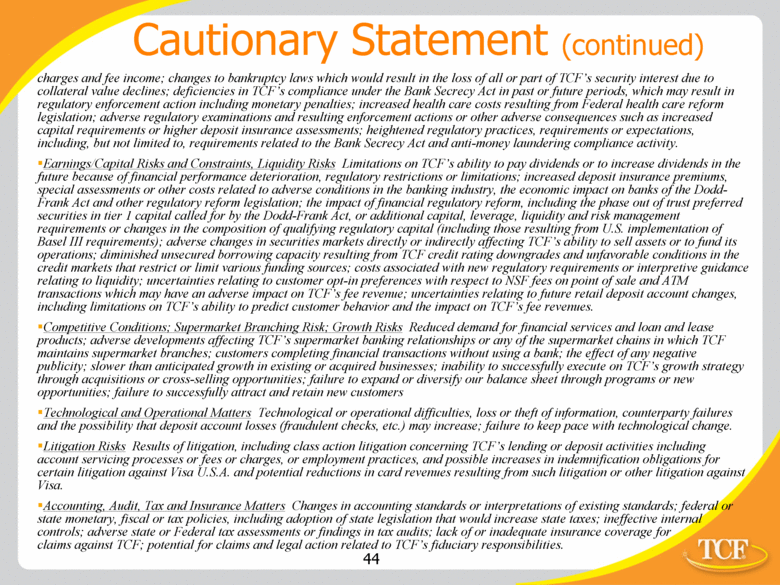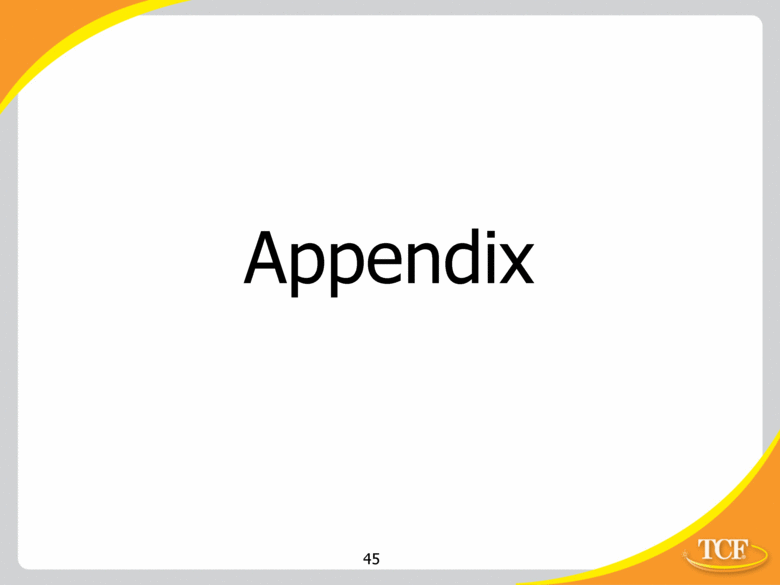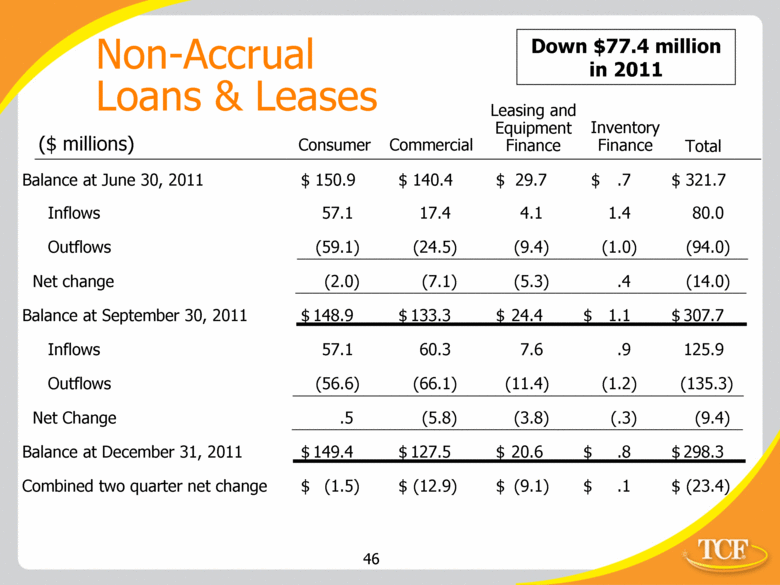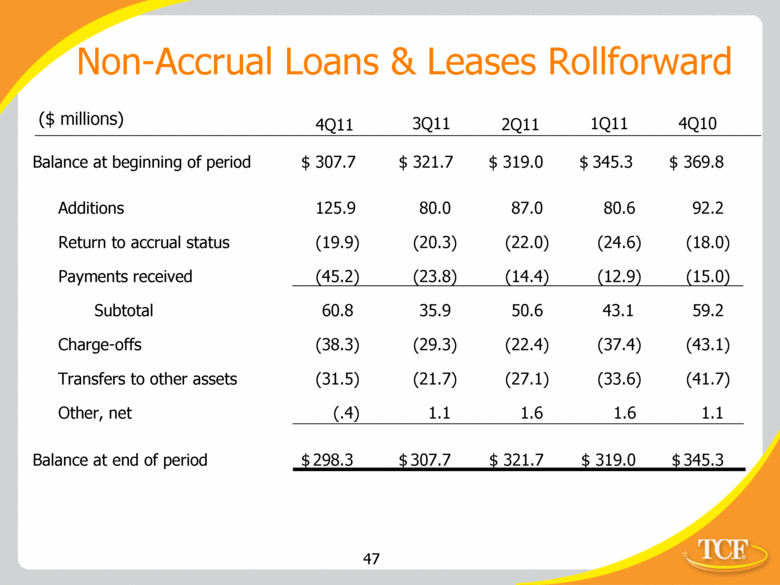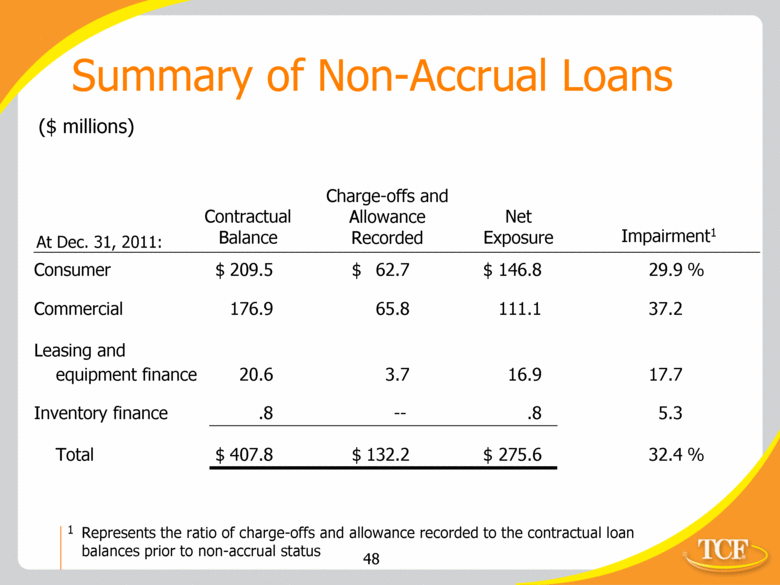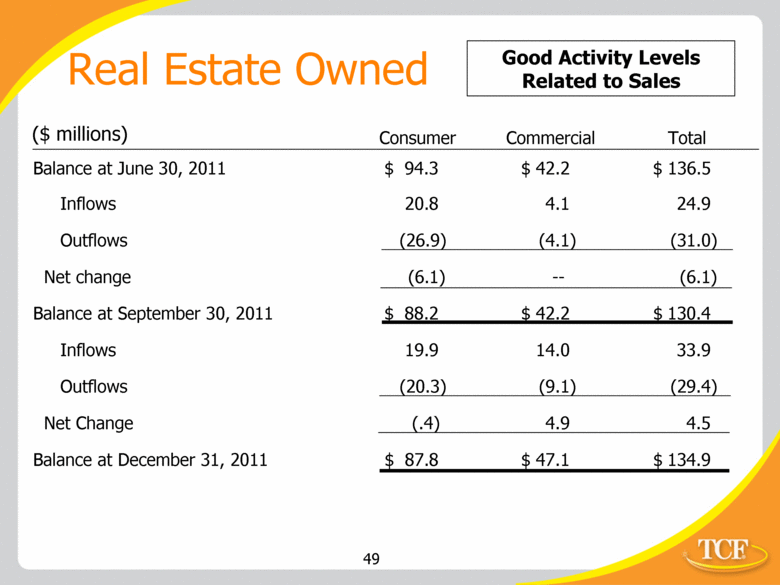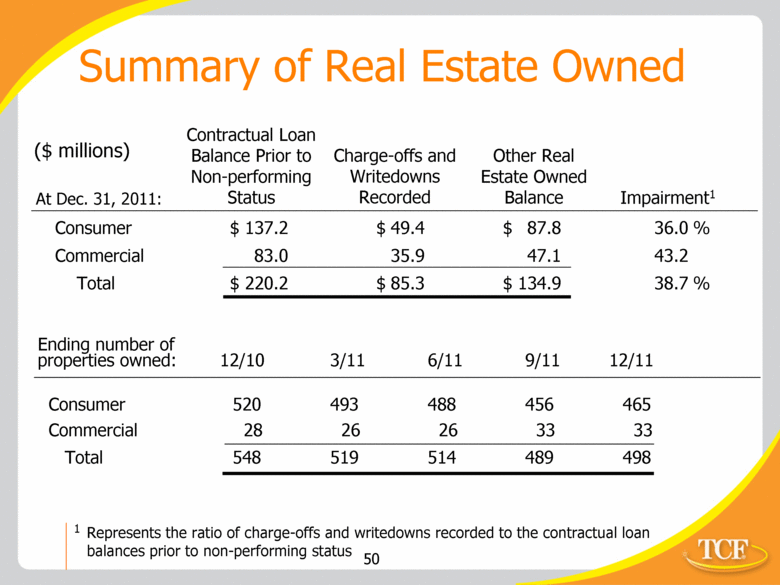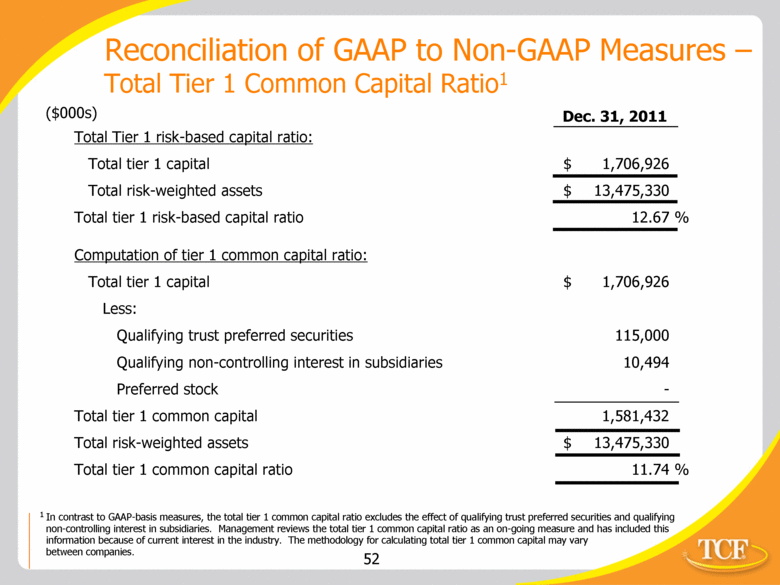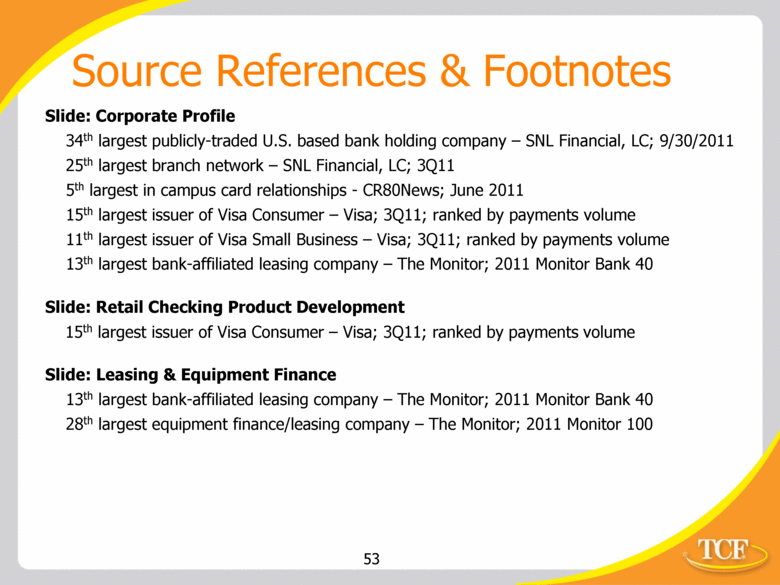Attached files
| file | filename |
|---|---|
| 8-K - 8-K - TCF FINANCIAL CORP | a12-4281_18k.htm |
Exhibit 99.1
|
|
TCF Financial Corporation 2011 Fourth Quarter Investor Presentation |
|
|
Table of Contents Corporate Profile 3 Strategic Overview 4 Revenue 10 Credit Quality 17 Capital 28 Balance Sheet Growth 30 Conclusion 40 Appendix 45 |
|
|
Consumer Lending $6.934 Commercial Lending $3,449 Inventory Finance $625 Commercial Lending $1,782 Consumer Lending $5,909 $19 billion national bank holding company headquartered in Minnesota 34th largest publicly-traded U.S. based bank holding company by asset size 434 bank branches in eight states, 25th largest U.S. branch network Five campus alliances; 5th largest in campus card banking relationships 669 ATMs available free to TCF customers; 211 off-site 15th largest issuer of Visa® Consumer debit cards 11th largest issuer of Visa Small Business debit cards 2 million retail deposit accounts 13th largest bank-affiliated leasing company in the U.S. Total equity to total assets of 9.90% Tangible realized common equity of 8.42%1 21st consecutive year of profitability Corporate Profile At December 31, 2011 1 36 7 110 26 53 196 5 Well-Diversified Loan Portfolio ($ millions) 5% 49% 24% 22% At 12/31/00 69% 21% 10% 1 See “Reconciliation of GAAP to Non-GAAP Measures – Tangible Realized Common Equity” slide At 12/31/11 Branch Summary Leasing & Equipment Finance $856 Leasing & Equipment Finance $3,142 |
|
|
Strategic Overview |
|
|
Executive Summary Current Credit quality metrics are slowly improving; however, provision has remained elevated Large commercial loan work-out expected resolutions are resulting in higher reserves and net charge-offs, which is based on the timing of a number of transactions Consumer lending charge-offs remain elevated, but home values appear to be stabilizing Durbin Amendment impact Approximately $15 million in lost revenue per quarter, which began in 4Q11 No silver bullet, mitigation expected throughout 2012 through other revenues and expense reductions Magnitude and speed of mitigation is driven by the competitive landscape and customers adapting to the new checking account product offering Investments in BRP and Gateway One are impacting short-term expenses, as these businesses ramp-up assets later in 2012 Opt-in impact is normalized Reg E resulted in decreased revenue Evolution of TCF |
|
|
Executive Summary 2012 Outlook – A Building & Investing Year Focus on asset growth, especially in specialty finance BRP and Gateway One will continue to have startup expenses in 2012, with earning asset levels ramping up throughout the year Stabilizing credit quality Mature loan portfolios to remain stable Continue to focus on optimizing retail checking products to grow profitable accounts Continue evolution of TCF, focus on diversified regional and national lending businesses funded by regional deposit platform |
|
|
What Makes TCF Different Convenience TCF attracts a large and diverse customer base by offering a host of convenient banking services: Traditional, supermarket and campus branches open seven days a week Free debit cards, free coin counting and 669 free ATMs available TCF Free Online Banking TCF Free Mobile Banking Customer friendly checking options National Lending Platforms Focus on asset growth through disciplined expansion of national lending platforms Conservative Corporate Philosophy Secured and diversified lender Conservative underwriting Conservative accounting Minimized interest-rate risk Prudent capital and liquidity management At December 31, 2011 |
|
|
The Evolution of TCF As a result of the current economic and regulatory challenges, TCF is being proactive in positioning itself for the future while remaining true to its conservative corporate philosophy Growth and Asset Diversification Focus on disciplined asset growth (including the expansion of national lending platforms) and creating a more equal diversification between consumer real estate products, commercial and specialty finance Deposits and Revenue Increase deposits and accounts through convenience, customer-friendly products and incentives Implementation of innovative checking account products Introduction of new checking account product that encourages transaction activity to avoid fees Evaluate and implement additional revenue-producing and expense reduction strategies throughout the company New Functionally Organized Management Structure Focus on four key areas: Enterprise Risk Management, Lending, Funding and Corporate Development Bolsters TCF’s evolution to accommodate today’s changing banking and economic environment |
|
|
Benefits: Bolsters TCF’s evolution to accommodate today’s changing banking and economic environment Highly responsive and performance driven culture Aligns TCF’s experienced management team to maximize their individual skills moving forward Functionally Organized Structure Enterprise Risk Management Neil Brown Credit Internal Audit & Investigations Lending Craig Dahl Commercial Banking Retail Lending Specialty Finance TCF Equipment Finance Winthrop Resources TCF Inventory Finance Gateway One Funding, Operations & Finance Tom Jasper Branch Banking Treasury Bank Operations, Services & IT Controllers Corp. Communications Protect & Increase Shareholder Value William Cooper Human Resources and Benefits Legal, Compliance & BSA Corporate Development Barry Winslow Strategic Planning New Business Segment Expansion Mergers and Acquisitions New Strategic Partnerships |
|
|
Revenue |
|
|
Banking Fees and Service Charges $51 ATM Revenue and Other $13 Specialty Finance $21 Card Revenue $14 Net Interest Income $173 Diversified Revenue Base Total Revenues1 Mix of Non-Interest Income1 ($ millions) 52% 14% 13% 21% 1 Quarter-to-date At December 31, 2011 ($ millions) 64% 36% Non-Interest Income $99 $272 Million1 $99 Million1 Diversified sources of revenue developed over time Mix of revenue is evolving Opportunity to increase Specialty Finance fees with Gateway One acquisition Specialty Finance made up just 12% of total non-interest income in 4Q 2000. |
|
|
$295 $288 $291 $292 $265 12/10 3/11 6/11 9/11 12/11 350 300 250 150 100 50 0 Non-Interest Income (Retail Lending, Commercial & Specialty Finance) Non-Interest Income (Branch Banking & Other) Net Interest Income Core Revenue1 ($ millions) At December 31, 2011 1 Core revenue excludes gains on securities $95 $174 $85 $174 $90 $176 $92 $176 $68 $173 $24 $24 $25 $29 $26 |
|
|
200 150 100 50 0 12/10 3/11 6/11 9/11 12/11 5.00 4.50 4.00 3.5 3.00 $174 $174 $176 $173 4.05% 4.06% 4.02% 3.96% 3.92% Net Interest Income ($ millions) (Percent) Margin compression has been nominal despite the level of legacy borrowings still on the balance sheet |
|
|
Total Deposits $12.1 billion Borrowings $4.4 billion Capital and Other $2.4 billion Funding Sources1 23% 13% At December 31, 2011 64% Rate on deposits of .32%2 Rate on borrowings of 4.232 Long-term and short-term borrowings of $4.4 billion and $37.1 million, respectively $1.9 billion in unused, secured borrowing capacity at the FHLB of Des Moines $518 million in unused, secured borrowing capacity at the Federal Reserve Discount Window 1 Quarterly average 2 Annualized |
|
|
Among the first to introduce Free Checking in 1986 1.3 million retail checking accounts Leader in debit card innovations 15th largest issuer of Visa® consumer debit cards Solid Reg E opt-in results due to proactive customer education 75% of new customers opt-in Launched TCF Free Mobile Banking in January 2011 Effective November 2011, monthly maintenance fee waived for customers completing at least 15 qualifying transactions per month Removed minimum balance and direct deposit requirements Expanded roll-out of daily overdraft product to all TCF markets – Michigan pilot success did not transfer well to other markets and as a result, TCF introduced additional overdraft product options Retail Checking Product Development |
|
|
Headwinds Competitive landscape and customers adapting to the new account product offerings Continued sluggish economy results in a lack of growth and aggressive competitor pricing Real estate lending credit quality Legacy long-term borrowing costs Tailwinds Growth in net interest income through balance sheet expansion, including new specialty finance programs such as BRP Acquisition of Gateway One Lending & Finance Net margin benefit through future growth in net interest income Gains on sales of loans creates additional fee opportunity Opportunities for cross-selling of various TCF products and services via specialty finance dealer base Future Considerations |
|
|
Credit Quality |
|
|
Current Strong performance on REO sales activity resulting in lower non-performing assets but increased net charge-offs Delinquencies and net charge-offs remain below peak 2010 levels; however, net charge-off levels may remain consistent with recent performance over the next couple of quarters Encouraging trends in non-accrual assets Commercial net charge-offs and provision tend to be lumpy as credits are worked out, which is expected to impact results into 2012 TDRs performing as expected; however, these extensions/modifications tend to carry higher reserve levels Credit Quality Summary |
|
|
2012 Outlook Continued strong credit performance expected in the specialty finance businesses Continued decline in non-performing assets through REO sales, paydowns and returning loans to accrual status based on performance Consumer delinquencies and net charge-offs may remain at elevated levels due to the sluggish economy, but home values appear to be stabilizing Slowly improving work-out environment for commercial real estate non-performing assets Credit Quality Summary |
|
|
550 500 450 400 350 3/10 6/10 8/10 12/10 3/11 6/11 9/11 12/11 Total Non-Performing Asset1 Trends $433 $461 $438 $407 $448 $506 $486 $458 ($ millions) 5th Consecutive Quarter NPAs Have Declined 1 Includes non-accrual loans and leases, properties owned and foreclosed properties subject to redemption |
|
|
150 125 100 75 50 25 0 3/10 6/10 9/10 12/10 3/11 6/11 9/11 12/11 Over 60-day Delinquencies 1 Net Charge-offs Delinquency & Net Charge-off Trends 1 Excludes acquired portfolios and non-accrual loans and leases 1 ($ millions) $65 $58 $45 $48 $58 $53 $103 $114 $114 $121 $107 $109 $97 $101 $44 $56 |
|
|
.29% .78% 1.34% 1.47% 1.45% $80.9 $172.4 $244.5 $265.8 $255.7 Allowance as a % of period end loans & leases: .65 % 1.29 % 1.68 % 1.80 % 1.81 % Ratio of allowance to net charge-offs: 2.3 X 1.7 X 1.3 X 1.2 X 1.2 X Allowance for Loan & Lease Losses Net Charge-Offs 1 ($ millions) (Percent) 1 As a % of average loans and leases 1 |
|
|
Specialty Finance Commercial Lending ($ millions) 23 $196 $229 $208 $213 $201 Commercial & Specialty Finance Non-Performing Assets |
|
|
Non-Accrual Loans & Leases Real Estate Owned ($ millions) 24 $237 $258 $253 $245 $237 Consumer Non-Performing Assets |
|
|
Consumer Real Estate TDR Process Loans modified to assist qualifying customers with their financial hardship by lowering their monthly loan payments Individually underwrite each TDR following face-to-face, in-property interview Generally determine interest rate and payment based on debt-to-income ratio of 38% Program terms up to five-years with interest/payment reduction, no principal forgiven These people can make payments and want to stay in their houses! |
|
|
Accruing Consumer Real Estate TDRs ($ millions) 26 $433 $337 $350 $364 $379 Continue to use TDR programs to mitigate losses |
|
|
Consumer Real Estate TDR Summary At December 31, 2011, TCF held $433.1 million of accruing modified consumer real estate loans that are considered TDRs (weighted average rate of 3.7%), a net increase of $95.7 million, or 28.4% from December 31, 2010 The reserves are based on present value of expected cash flows – $58.3 million, or 13.5% at December 31, 2011 Fourth quarter annualized net charge-offs of 6.5% The over 60-day delinquency rate was 7% at December 31, 2011, up slightly from 6.8% at September 30, 2011 |
|
|
Capital |
|
|
6.05% 5.84% 5.75% 7.28% 8.42% $957 $969 $1,020 $1,334 $1,579 Tangible Realized Common Equity 1 Tangible Realized Common Equity Ratio 1 1 See “Reconciliation of GAAP to Non-GAAP Measures – Tangible Realized Common Equity” slide 2 See “Reconciliation of GAAP to Non-GAAP Measures – Total Tier 1 Common Capital Ratio” slide Capital Ratios – Holding Company ($ millions) At December 31, 2011 Other Capital Ratios Total equity to total assets – 9.90% Total tier 1 common capital – 11.74%2 Total risk-based capital – 14.80% 1 1 |
|
|
Balance Sheet Growth |
|
|
$9,482 $9,849 $11,386 $11,455 $12,103 Certificates of Deposit (CDs) Checking Money Market Savings Strong Deposit Franchise Quarterly Average Balances ($ millions) Average rate1: 2.29% 1.51% .74% .46% .32% CDs as a % of total deposits: 24.3% 24.9% 12.0% 9.1% 9.2% 1 Quarter-to-date (annualized) High Quality Core Deposit Base |
|
|
Comsuner Lending Commercial Lending Leasing and Equipment Finance & Inventory Finance $12,494 $13,346 $14,591 $14,788 $14,150 Loan Balances ($ millions) Diverse Products and Geographies 5-Year CAGR .6% 3.2% 15.7% |
|
|
Loan & Lease Geographic Diversification Consumer Real Estate and Other At Dec. 31, 2011: ($000s) Commercial Real Estate and Commercial Business Leasing and Equipment Finance Inventory Finance Total Minnesota $ 2,750,344 $ 873,759 $ 91,258 $ 14,755 $ 3,730,116 Illinois 2,118,618 794,389 102,565 17,814 3,033,386 Michigan 924,252 671,296 124,583 16,484 1,736,615 Wisconsin 459,741 621,271 57,573 16,708 1,155,293 Colorado 574,569 104,749 42,950 4,093 726,361 California 2,395 17,505 395,319 18,176 433,395 Texas 209 2,549 248,477 32,171 283,406 Florida 3,694 55,592 167,160 29,358 255,804 Ohio 2,268 46,838 128,136 25,378 202,620 Indiana 23,417 101,912 58,945 15,653 199,927 New York 2,162 -- 175,707 18,948 196,817 Canada -- -- 3,069 168,405 171,474 Arizona 53,461 33,702 73,983 5,992 167,138 Pennsylvania 57 -- 137,162 23,579 160,798 Other 18,617 125,930 1,335,372 217,186 1,697,105 Total $ 6,933,804 $ 3,449,492 $ 3,142,259 $ 624,700 $ 14,150,255 33 |
|
|
Core Portfolio Acquired Portfolio $2,175 $2,545 $3,177 $3,232 $3,212 Leasing & Equipment Finance1 1 Includes operating leases ($69.6 million at December 31, 2011) 2 Excludes non-accrual loans and leases and acquired portfolios ($ millions) At December 31, 2011 13th largest bank-affiliated leasing company and 28th largest equipment finance/leasing company in the U.S. Diverse equipment types 22% specialty vehicles, 15% manufacturing, 14% medical, 11% construction 2011 year-to-date fee revenue of $89.2 million, 20% of total fees and other revenue 6.0% average yield 2011 year-to-date originations are up 17.8% from same 2010 period Over 60-day delinquency rate .13%2 Net charge-offs: 2011 2010 2009 .41% 1.00% .97% Uninstalled backlog of $455.3 million Unguaranteed residuals of only $129.1 million, or 6.4% of leases Core portfolio increased 6% year-over-year |
|
|
Electronics & Appliances Lawn & Garden Powersports & Other TCF Inventory Finance ($ millions) $4 $469 $625 At December 31, 2011 Inventory floorplan finance business with a focus on lawn and garden products, powersports, consumer electronics and appliances, recreation vehicles and marine products Experienced and seasoned management Operates in the U.S. and Canada 274 employees 100% variable-rate receivables Average yield 7.19% Net charge-offs: 2011 2010 .10% .17% Credit support from equipment manufacturers Credit risk spread across more than 7,100 active dealers Strong Traction in Multiple Origination Segments $792 |
|
|
Bombardier Recreational Products Inc. (BRP) Agreement BRP multi-year strategic alliance launched in September 2011, potential for approximately $600 million in average net receivables when mature (2013) Includes dealers in the U.S. and Canada Loan originations to start in 1Q 2012 Credit risk spread across 1,600 active dealers and supported by BRP Further enhances TCF’s credibility in Inventory Finance marketplace Inventory Finance Update Continued growth through recent activities: September 2011 – Established BRP exclusive floorplan financing program August 2011 – Established Alumacraft exclusive floorplan financing program May 2011 – Established Jayco preferred floorplan financing program August 2010 – Assumed Arctic Cat Canadian exclusive floorplan financing program August 2010 – Assumed E-Z-GO exclusive floorplan financing program August 2009 – Created Red Iron Acceptance LLC, a joint venture with The Toro Company |
|
|
Gateway One Auto Lending At December 31, 2011 On November 30, 2011, TCF completed the acquisition of Gateway One Lending & Finance, LLC Indirect auto finance company headquartered in Anaheim, CA More than 3,400 active dealer relationships originating loans to consumers in 30 states Originates and services primarily used retail auto loans acquired from franchised and independent dealers across the country Managed portfolio of $437.7 million Strong growth potential due to large U.S. auto lending marketplace (2nd largest consumer finance market in the U.S.) Incremental source of balance sheet growth and fee income while transitioning from an originate-to-sell model to an originate-to-hold model Attractive risk-adjusted yields on a geographically diverse portfolio |
|
|
Commercial Business Commercial Real Estate $3,116 $3,491 $3,719 $3,646 $3,449 Commercial Lending ($ millions) At December 31, 2011 Commercial real estate – $3.2 billion 29% apartment loans 25% retail services 17% office buildings 13% industrial buildings Commercial highlights 5.47% average yield 84% fixed-rate, 16% variable-rate Over 60-day delinquency rate .03%1 Net charge-offs: 2011 2010 2009 1.15% 1.31% 1.24% CRE location mix: 93% TCF banking markets, 7% other Looking for strategic expansion opportunities that fit TCF’s profile 1 Excludes non-accrual loans Secured Lending Philosophy |
|
|
Loans Originated prior to 1/1/09 Loans Originated since 1/1/09 74% first mortgage lien positions, average loan amount of $121,563 26% junior lien positions, average loan amount of $41,055 65% fixed-rate, 35% variable-rate Average home value of $257,994 1 Yields: 6.08% fixed-rate, 5.13% variable-rate Over 60-day delinquency rate of 1.63%2 Net charge-offs: 2011 2010 2009 2.18% 1.80% 1.46% Average FICO score of the retail lending operation: At origination – 727; updated 4Q11 – 727 26% of loan balance has been originated since January 1, 2009, with 2011 net charge-offs of .20% Consumer Real Estate ($ millions) 1 Based on value at origination 2 Excludes non-accrual loans $6,895 $7,051 $7,281 $7,156 $7,302 At December 31, 2011 |
|
|
Conclusion |
|
|
Summary On the Lending side: Focus on disciplined asset growth, especially through national specialty finance lending platforms Maintain strong asset quality and earnings from Leasing and Equipment Finance Ramp up asset levels throughout the year in Inventory Finance while maintaining superior asset quality levels as business will near model profit levels by year-end 2012 Integrate Gateway One and execute on growth plans – expect the acquisition to be slightly accretive in 2012, primarily in the last six months Continue the Commercial Real Estate strategy by being opportunistic on new business in all footprint geographies, while dedicated work-out teams optimize the problem credits In Retail Lending, continue to work with our borrowers to provide mutually beneficial solutions, while being selective in asset generation focusing on profitability and diversification |
|
|
Summary (continued) On the Capital and Funding side: Integrate funding strategies keeping in mind the best equity mix and keeping an eye on reducing the loan-to-deposit ratio over time Redesign of retail checking products to compete effectively in the marketplace and to meet various customer needs Capitalize on the deposit gathering strength of TCF’s branch network to continue to fund balance sheet growth in the most stable and economic methods Continue to use capital for strategic purposes Organizationally: New, functionally organized management structure (Enterprise Risk Management, Lending, Funding and Corporate Development) will bolster TCF’s evolution to accommodate today’s changing banking and economic environment |
|
|
Cautionary Statement Any statements contained in this presentation regarding the outlook for the Company’s businesses and their respective markets, such as projections of future performance, guidance, statements of the Company’s plans and objectives, forecasts of market trends and other matters, are forward-looking statements based on the Company’s assumptions and beliefs. Such statements may be identified by such words or phrases as “will likely result,” “are expected to,” “will continue,” “outlook,” “will benefit,” “is anticipated,” “estimate,” “project,” “management believes” or similar expressions. These forward-looking statements are subject to certain risks and uncertainties that could cause actual results to differ materially from those discussed in such statements and no assurance can be given that the results in any forward-looking statement will be achieved. For these statements, TCF claims the protection of the safe harbor for forward-looking statements contained in the Private Securities Litigation Reform Act of 1995. Any forward-looking statement speaks only as of the date on which it is made, and we disclaim any obligation to subsequently revise any forward-looking statement to reflect events or circumstances after such date or to reflect the occurrence of anticipated or unanticipated events. Certain factors could cause the Company’s future results to differ materially from those expressed or implied in any forward-looking statements contained in this release. These factors include the factors discussed in Part I, Item 1A of the Company’s Annual Report on Form 10-K under the heading “Risk Factors,” the factors discussed below and any other cautionary statements, written or oral, which may be made or referred to in connection with any such forward-looking statements. Since it is not possible to foresee all such factors, these factors should not be considered as complete or exhaustive. Adverse Economic or Business Conditions, Credit and Other Risks Deterioration in general economic and banking industry conditions, including defaults, anticipated defaults or rating agency downgrades of sovereign debt (including debt of the U.S.), or continued high rates of or increases in unemployment in TCF’s primary banking markets; adverse economic, business and competitive developments such as shrinking interest margins, deposit outflows, deposit account attrition or an inability to increase the number of deposit accounts; adverse changes in credit quality and other risks posed by TCF’s loan, lease, investment and securities available for sale portfolios, including declines in commercial or residential real estate values or changes in the allowance for loan and lease losses dictated by new market conditions or regulatory requirements; interest rate risks resulting from fluctuations in prevailing interest rates or other factors that result in a mismatch between yields earned on TCF’s interest-earning assets and the rates paid on its deposits and borrowings; foreign currency exchange risks; counterparty risk, including the risk of defaults by our counterparties or diminished availability of counterparties who satisfy our credit quality requirements; decreases in demand for the types of equipment that TCF leases or finances; limitations on TCF’s ability to attract and retain manufacturers and dealers to expand the inventory finance business. Legislative and Regulatory Requirements New consumer protection and supervisory requirements and regulations, including those resulting from action by the CFPB and changes in the scope of Federal preemption of state laws that could be applied to national banks; the imposition of requirements with an adverse impact relating to TCF’s lending, loan collection and other business activities as a result of the Dodd-Frank Act, or other legislative or regulatory developments such as mortgage foreclosure moratorium laws or imposition of underwriting or other limitations that impact the ability to use certain variable-rate products; reduction of interchange revenue from debit card transactions resulting from the Durbin Amendment to the Dodd-Frank Act; impact of legislative, regulatory or other changes affecting customer account (continued) |
|
|
Cautionary Statement (continued) charges and fee income; changes to bankruptcy laws which would result in the loss of all or part of TCF’s security interest due to collateral value declines; deficiencies in TCF’s compliance under the Bank Secrecy Act in past or future periods, which may result in regulatory enforcement action including monetary penalties; increased health care costs resulting from Federal health care reform legislation; adverse regulatory examinations and resulting enforcement actions or other adverse consequences such as increased capital requirements or higher deposit insurance assessments; heightened regulatory practices, requirements or expectations, including, but not limited to, requirements related to the Bank Secrecy Act and anti-money laundering compliance activity. Earnings/Capital Risks and Constraints, Liquidity Risks Limitations on TCF’s ability to pay dividends or to increase dividends in the future because of financial performance deterioration, regulatory restrictions or limitations; increased deposit insurance premiums, special assessments or other costs related to adverse conditions in the banking industry, the economic impact on banks of the Dodd-Frank Act and other regulatory reform legislation; the impact of financial regulatory reform, including the phase out of trust preferred securities in tier 1 capital called for by the Dodd-Frank Act, or additional capital, leverage, liquidity and risk management requirements or changes in the composition of qualifying regulatory capital (including those resulting from U.S. implementation of Basel III requirements); adverse changes in securities markets directly or indirectly affecting TCF’s ability to sell assets or to fund its operations; diminished unsecured borrowing capacity resulting from TCF credit rating downgrades and unfavorable conditions in the credit markets that restrict or limit various funding sources; costs associated with new regulatory requirements or interpretive guidance relating to liquidity; uncertainties relating to customer opt-in preferences with respect to NSF fees on point of sale and ATM transactions which may have an adverse impact on TCF’s fee revenue; uncertainties relating to future retail deposit account changes, including limitations on TCF’s ability to predict customer behavior and the impact on TCF’s fee revenues. Competitive Conditions; Supermarket Branching Risk; Growth Risks Reduced demand for financial services and loan and lease products; adverse developments affecting TCF’s supermarket banking relationships or any of the supermarket chains in which TCF maintains supermarket branches; customers completing financial transactions without using a bank; the effect of any negative publicity; slower than anticipated growth in existing or acquired businesses; inability to successfully execute on TCF’s growth strategy through acquisitions or cross-selling opportunities; failure to expand or diversify our balance sheet through programs or new opportunities; failure to successfully attract and retain new customers Technological and Operational Matters Technological or operational difficulties, loss or theft of information, counterparty failures and the possibility that deposit account losses (fraudulent checks, etc.) may increase; failure to keep pace with technological change. Litigation Risks Results of litigation, including class action litigation concerning TCF’s lending or deposit activities including account servicing processes or fees or charges, or employment practices, and possible increases in indemnification obligations for certain litigation against Visa U.S.A. and potential reductions in card revenues resulting from such litigation or other litigation against Visa. Accounting, Audit, Tax and Insurance Matters Changes in accounting standards or interpretations of existing standards; federal or state monetary, fiscal or tax policies, including adoption of state legislation that would increase state taxes; ineffective internal controls; adverse state or Federal tax assessments or findings in tax audits; lack of or inadequate insurance coverage for claims against TCF; potential for claims and legal action related to TCF’s fiduciary responsibilities. |
|
|
Appendix |
|
|
Non-Accrual Loans & Leases ($ millions) Consumer Commercial Leasing and Equipment Finance Inventory Finance Total Balance at June 30, 2011 $ 150.9 $ 140.4 $ 29.7 $ .7 $ 321.7 Inflows 57.1 17.4 4.1 1.4 80.0 Outflows (59.1) (24.5) (9.4) (1.0) (94.0) Net change (2.0) (7.1) (5.3) .4 (14.0) Balance at September 30, 2011 $ 148.9 $ 133.3 $ 24.4 $ 1.1 $ 307.7 Inflows 57.1 60.3 7.6 .9 125.9 Outflows (56.6) (66.1) (11.4) (1.2) (135.3) Net Change .5 (5.8) (3.8) (.3) (9.4) Balance at December 31, 2011 $ 149.4 $ 127.5 $ 20.6 $ .8 $ 298.3 Combined two quarter net change $ (1.5) $ (12.9) $ (9.1) $ .1 $ (23.4) Down $77.4 million in 2011 |
|
|
Balance at beginning of period $ 307.7 $ 321.7 $ 319.0 $ 345.3 $ 369.8 Additions 125.9 80.0 87.0 80.6 92.2 Return to accrual status (19.9) (20.3) (22.0) (24.6) (18.0) Payments received (45.2) (23.8) (14.4) (12.9) (15.0) Subtotal 60.8 35.9 50.6 43.1 59.2 Charge-offs (38.3) (29.3) (22.4) (37.4) (43.1) Transfers to other assets (31.5) (21.7) (27.1) (33.6) (41.7) Other, net (.4) 1.1 1.6 1.6 1.1 Balance at end of period $ 298.3 $ 307.7 $ 321.7 $ 319.0 $ 345.3 Non-Accrual Loans & Leases Rollforward ($ millions) 4Q11 3Q11 2Q11 1Q11 4Q10 |
|
|
Summary of Non-Accrual Loans Charge-offs and Allowance Recorded Net Exposure Contractual Balance ($ millions) Impairment1 At Dec. 31, 2011: Represents the ratio of charge-offs and allowance recorded to the contractual loan balances prior to non-accrual status 1 Consumer $ 209.5 $ 62.7 $ 146.8 29.9 % Commercial 176.9 65.8 111.1 37.2 Leasing and equipment finance 20.6 3.7 16.9 17.7 Inventory finance .8 -- .8 5.3 Total $ 407.8 $ 132.2 $ 275.6 32.4 % |
|
|
Real Estate Owned ($ millions) Consumer Commercial Total Good Activity Levels Related to Sales Balance at June 30, 2011 $ 94.3 $ 42.2 $ 136.5 Inflows 20.8 4.1 24.9 Outflows (26.9) (4.1) (31.0) Net change (6.1) -- (6.1) Balance at September 30, 2011 $ 88.2 $ 42.2 $ 130.4 Inflows 19.9 14.0 33.9 Outflows (20.3) (9.1) (29.4) Net Change (.4) 4.9 4.5 Balance at December 31, 2011 $ 87.8 $ 47.1 $ 134.9 |
|
|
Summary of Real Estate Owned Charge-offs and Writedowns Recorded Other Real Estate Owned Balance ($ millions) Contractual Loan Balance Prior to Non-performing Status At Dec. 31, 2011: Impairment1 Represents the ratio of charge-offs and writedowns recorded to the contractual loan balances prior to non-performing status 1 Consumer $ 137.2 $ 49.4 $ 87.8 36.0 % Commercial 83.0 35.9 47.1 43.2 Total $ 220.2 $ 85.3 $ 134.9 38.7 % Ending number of properties owned: 12/10 3/11 6/11 9/11 12/11 Consumer 520 493 488 456 465 Commercial 28 26 26 33 33 Total 548 519 514 489 498 |
|
|
1 In contrast to GAAP-basis measures, tangible realized common equity excludes the effect of goodwill, other intangibles and accumulated other comprehensive income (loss). Management reviews tangible realized common equity as an ongoing measure and has included this information because of current interest in the industry. The methodology for calculating tangible realized common equity may vary between companies. Reconciliation of GAAP to Non-GAAP Measures – Tangible Realized Common Equity1 Computation of total equity to total assets: Total equity $ 1,099,012 $ 1,493,776 $ 1,179,755 $ 1,480,163 $ 1,878,627 Total assets $ 15,977,054 $ 16,740,357 $ 17,885,175 $ 18,465,025 $ 18,979,388 Total equity to total assets 6.88 % 8.92 % 6.60 % 8.02 % 9.90 % Computation of tangible realized common equity to tangible assets Total equity $ 1,099,012 $ 1,493,776 $ 1,179,755 $ 1,480,163 $ 1,878,627 Less: Non-controlling interest in subsidiaries - - 4,393 8,500 10,494 Total TCF stockholders’ equity 1,099,012 1,493,776 1,175,362 1,471,663 1,868,133 Less: Goodwill 152,599 152,599 152,599 152,599 225,640 Customer based intangibles - - 1,405 1,232 7,134 Deposit based intangibles 1 - - - - Preferred Stock - 348,437 - - - Accumulated other comprehensive income - 23,685 1,661 - 56,826 Add: Accumulated other comprehensive loss 10,523 - - 15,692 - Tangible realized common equity $ 956,935 $ 969,055 $ 1,019,697 $ 1,333,524 $ 1,578,533 Total assets $ 15,977,054 $ 16,740,357 $ 17,885,175 $ 18,465,025 $ 18,979,388 Less: Goodwill 152,599 152,599 152,599 152,599 225,640 Customer based intangibles - - 1,405 1,232 7,134 Deposit based intangibles 1 - - - - Tangible assets $ 15,824,454 $ 16,587,758 $ 17,731,171 $ 18,311,194 $ 18,746,614 Total realized common equity to tangible 6.05 % 5.84 % 5.75 % 7.28 % 8.42 % assets Dec. 31, 2011 ($000s) Dec. 31, 2010 Dec. 31, 2009 Dec. 31, 2008 Dec. 31, 2007 |
|
|
Total Tier 1 risk-based capital ratio: Total tier 1 capital $ 1,706,926 Total risk-weighted assets $ 13,475,330 Total tier 1 risk-based capital ratio 12.67 % Computation of tier 1 common capital ratio: Total tier 1 capital $ 1,706,926 Less: Qualifying trust preferred securities 115,000 Qualifying non-controlling interest in subsidiaries 10,494 Preferred stock - Total tier 1 common capital 1,581,432 Total risk-weighted assets $ 13,475,330 Total tier 1 common capital ratio 11.74 % ($000s) Dec. 31, 2011 Reconciliation of GAAP to Non-GAAP Measures – Total Tier 1 Common Capital Ratio1 1 In contrast to GAAP-basis measures, the total tier 1 common capital ratio excludes the effect of qualifying trust preferred securities and qualifying non-controlling interest in subsidiaries. Management reviews the total tier 1 common capital ratio as an on-going measure and has included this information because of current interest in the industry. The methodology for calculating total tier 1 common capital may vary between companies. |
|
|
Source References & Footnotes Slide: Corporate Profile 34th largest publicly-traded U.S. based bank holding company – SNL Financial, LC; 9/30/2011 25th largest branch network – SNL Financial, LC; 3Q11 5th largest in campus card relationships - CR80News; June 2011 15th largest issuer of Visa Consumer – Visa; 3Q11; ranked by payments volume 11th largest issuer of Visa Small Business – Visa; 3Q11; ranked by payments volume 13th largest bank-affiliated leasing company – The Monitor; 2011 Monitor Bank 40 Slide: Retail Checking Product Development 15th largest issuer of Visa Consumer – Visa; 3Q11; ranked by payments volume Slide: Leasing & Equipment Finance 13th largest bank-affiliated leasing company – The Monitor; 2011 Monitor Bank 40 28th largest equipment finance/leasing company – The Monitor; 2011 Monitor 100 |

